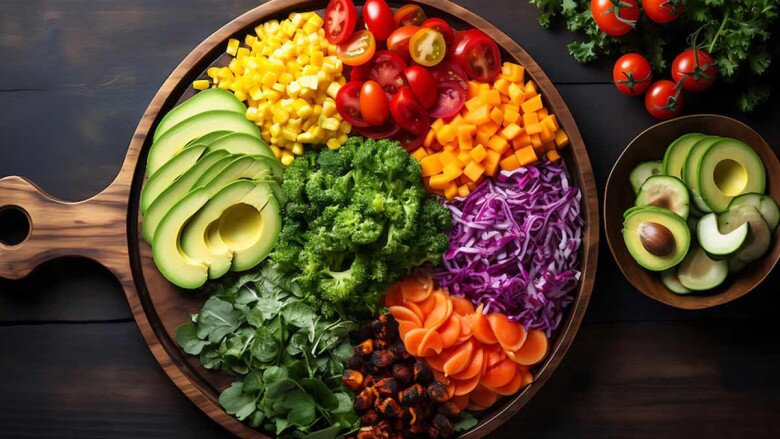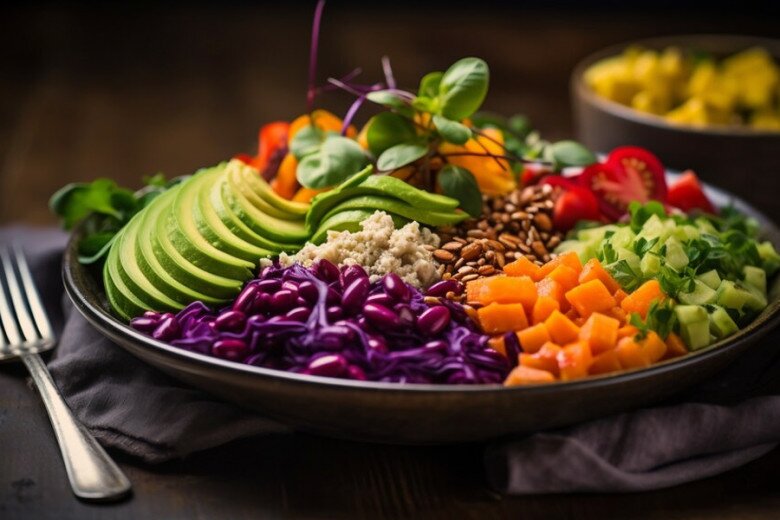
The Rainbow Diet. (Illustration)
What is the Rainbow Diet?
The Rainbow Diet encourages the consumption of a variety of fruits, vegetables, nuts, seeds, whole grains, and beans of different colors to boost your intake of micronutrients and plant compounds. The different colors in foods usually indicate different nutritional profiles, making it easier to ensure you’re getting all the essential vitamins and minerals. By focusing on a colorful plate, you can better meet your nutritional needs and support your overall health.
This diet heavily emphasizes plant-based foods, based on the colors of the rainbow. In the Rainbow Diet, singer Christina Aguilera eats specific colors of food each day. In addition to weight loss, this helps control portions by consuming more fruits and vegetables.
This diet centers on the core idea of “eating the rainbow.” It combines colorful fruits and vegetables packed with nutrients, antioxidants, and phytochemicals. The diet is categorized into color groups:
– Red foods: Red foods like tomatoes, grapefruit, and watermelon have anti-inflammatory properties and may also reduce the risk of heart disease and certain cancers.
Tomatoes, grapefruit, and watermelon are rich in lycopene, a plant nutrient with antioxidant properties. Lycopene is linked to improved heart, eye, skin, and bone health. However, it’s important to note that solely relying on red foods may miss out on other beneficial nutrients found in differently colored foods.
– White foods include onions, potatoes, and mushrooms.
– Yellow and orange foods, such as pineapple, bananas, and oranges, have similar benefits and may also support eye health.
Yellow foods are rich in carotenoids, which are part of the vitamin A family. These nutrients offer anti-inflammatory benefits and support eye, heart, and skin health. However, an excessive focus on these colors can lead to an imbalance if other colors and their respective nutrients are neglected.
– Green foods: Traditional green vegetables like lettuce, broccoli, and spinach are rich in antioxidants, while blue and purple foods, such as blueberries and raspberries, are believed to improve brain function and reduce the risk of certain neurological disorders.
Broccoli, spinach, and kale contain various plant compounds, including carotenoids, chlorophyll, and isothiocyanates and glucosinolates in cruciferous vegetables. These compounds have antioxidant, anti-inflammatory, and even cancer-fighting properties.
– Purple foods: Blueberries, purple cabbage, and plums contain anthocyanins, some of the most potent plant compounds, offering anti-inflammatory, heart-healthy, brain-boosting, and blood sugar-regulating benefits.
The Value of the Rainbow Diet
This diet boosts immune function and improves gut health and digestion through better bowel habits and a healthier microbiome. Additionally, it has potential cancer-fighting properties, reduces the risk of obesity and body fat, lowers the chances of heart disease, heart attacks, and strokes, helps control blood sugar levels, and reduces the risk of developing diabetes.

A typical “rainbow” meal. (Illustration)
How to Follow the Rainbow Diet Correctly?
Combining a variety of plant-based foods, approximately 30 different types, including fruits, vegetables, nuts, seeds, whole grains, beans, and legumes, can have tremendous benefits for overall health. This approach ensures you get plenty of fiber, micronutrients, and plant compounds, all of which support gut and overall health.
If you’re not used to consuming such a wide variety of plant foods, it’s best to introduce them gradually. A sudden increase in fiber intake can sometimes cause digestive discomfort if your body is unaccustomed to it. Starting slowly allows your digestive system to adjust and helps you enjoy the benefits of this approach without any discomfort.
The Secret to Flawless, Luminous Skin: Unveiling the Power of this Familiar Juice for a Brighter, More Even Complexion
“Tomato juice is a favorite among health and beauty enthusiasts, and for good reason. This humble drink packs a powerful punch when it comes to skincare and overall wellness. With its high concentration of vitamins and antioxidants, tomato juice provides a plethora of benefits that contribute to a radiant, youthful complexion. What’s more, tomatoes are easily accessible and affordable, making this juicy treat a convenient and cost-effective addition to any beauty routine.”



































